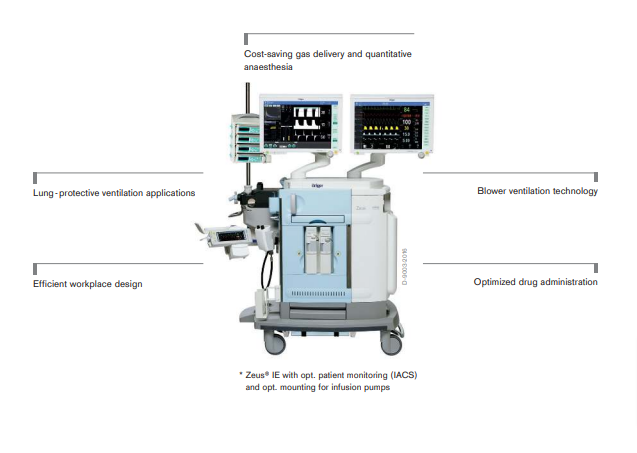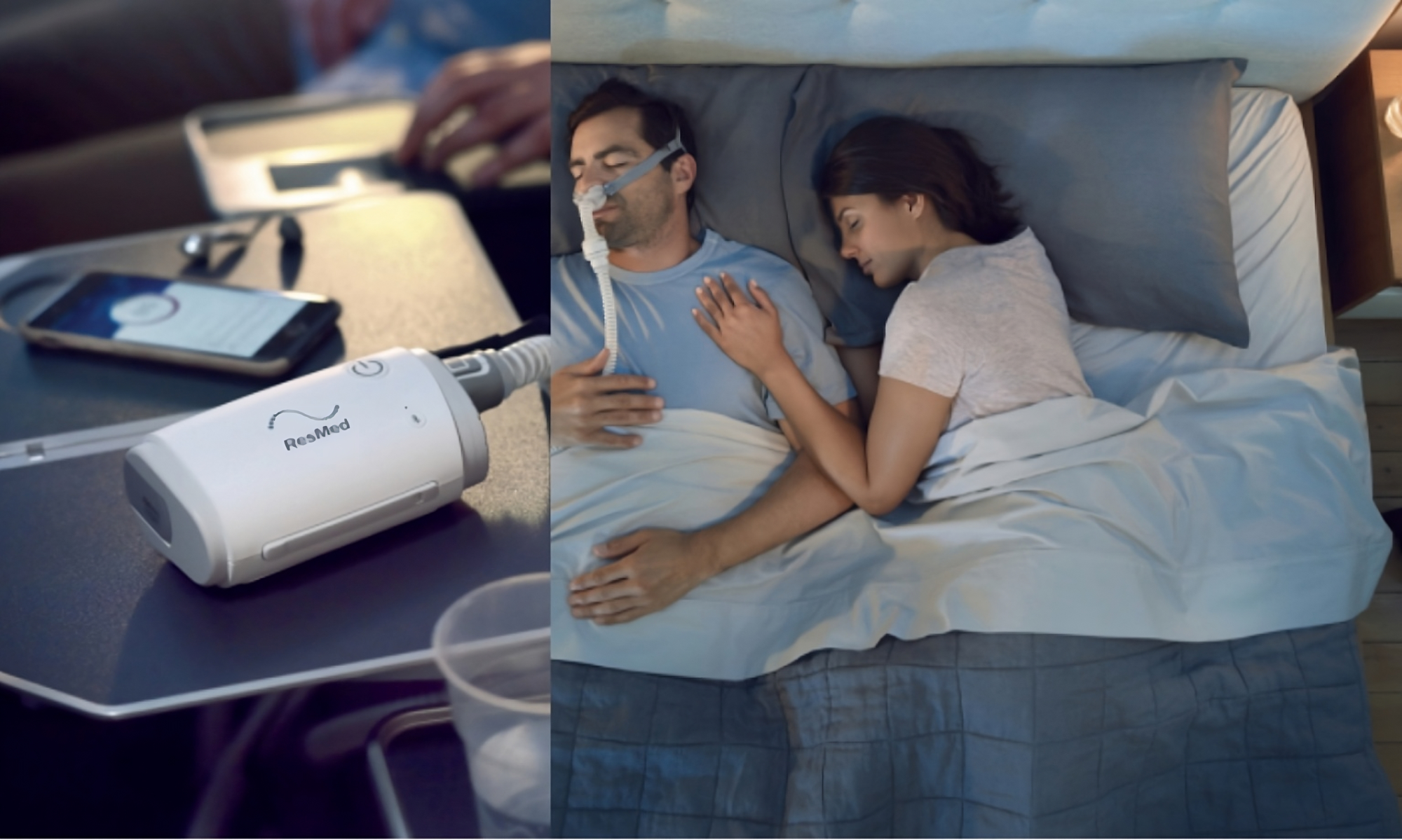Lung-protective ventilation functionalities, cost-saving gas delivery technology, decision-support tools and comprehensive monitoring. Zeus IE integrates them all into one advanced anaesthesia workstation. It can, hence, improve clinical outcome, workflow efficiency, and cost savings throughout the anesthesia process.

Benefits
Cost-saving gas delivery and Quantitative Anaesthesia
The Zeus IE can be operated in conventional Fresh Gas Mode and in Auto Control mode (Target Control Anaesthesia – TCA).
Auto Control mode (TCA):
— Less user interactions are required as clinician sets only the targets for FiO and expiratory anaesthetic agent
— Required amount of oxygen and anesthetic agent are delivered automatically according to the set targets
— Second gas analyzer supervises the measurement of patient gas analyzer to avoid overdosing (too deep anaesthesia) and underdosing of oxygen and anesthetic agents
Quantitative Anaesthesia (uptake mode):
— In wash-in and in steady-state, the system remains closed (metabolic flow). This means the patient uptake of oxygen and anaesthetic agent is replaced and therefore almost no waste of gases
— Lowest possible consumption of an anesthetic agent and oxygen to save costs per anesthesia procedure
— Complete rebreathing of patient gases for an optimized breathing gas acclimatization which can reduce post-operative pulmonary complications
— Reduced emissions of volatile anesthetic agents (greenhouse gases) which reduces considerably the ecological footprint of the entire hospital
Blower ventilation technology
The blower ventilator is a pressure source which requires no driving gas to operate. It reduces actively the inspiratory resistance to enable spontaneous breathing and hence reduces WOB, even in Man/Spont mode. The virtually unlimited flow enables very fast reaction times to even the weakest spontaneous breathing effort. The blower ventilator generates a circular flow that considerably reduces dead space at the Y-piece which is especially important when ventilating neonates:
— Facilitates and always supports the patient’s spontaneous breathing on both pressure levels (BiIPAP)
— Enables CPAP applicaton during Man/Spont to keep lungs of even obese and critically ill patients open
— Keeps the set PEEP level stable even in case of leakages
Lung-protective ventilation applications
Besides all traditional and sophisticated ventilation modes Zeus IE can be equipped with the following options which can enhance lung-protective ventilation applications in the OR. Lung-protective ventilation can contribute in the reduction of ventilator-induced lung injuries which can lead to postoperative pulmonary complications:
Smart Ventilation Control (SVC)
— Ventilation target set by clinician e.g. controlled, supported spontaneous breathing, or spontaneous breathing
— Automated and smocth transition from controlled ventilation to spontaneous breathing during anaesthesia course
— Reduction of user interactions by automated adaptation of ventilator support until the patient is ready for extubation
— Compliant with recommendations of respective healthcare societies how to protect lungs of surgical patients (e.g. tidal volume is set in ml per kg of ideal body weight)
-— Setting targeted etCO» range to avoid hypocapnia and hypercapnia
– Quick and easy start with ventilation by just setting patient height and ventilation target Lung Recruitment tool
— Two automated methods: Single-step and multi-step recrutiment manoeuvres to improve oxygenation and to avoid anaesthesia induced atelectasis
— Single-step maneouvre applies the set pressure for defined time and compares the lung complicance values before and after the maneouvre to asses the recruitment result
— Multi-step maneouvre applies incremental and decremental pressures based on settings by clinicians
— Cursor function to determine optimal PEEP during decremental phase in multi-step recruitment
— Automatic adjustment of pressure high alarm to avoid redundant alarms during recruitment maneouvres
— Reminder function enables for ensuring periodical application of the maneouvres
— During multi-step maneouvre the clinician can manually start the decremental phase to inhibit further increase of airway pressure which can negatively influence the haemodynamics of the patient
— Functions and parameters (e.g. PV Loops and compliance trends) help to assess if and when to deploy recrutiment maneouvres
Optimised drug administration
Integrated SmartPilot® View is a software option to simulate and visualise the combined effects of analgetics and hypnotics. Beside displaying current depth of anaesthesia it provides a 20 minute prediction for the course of anaesthesia. This assists clinicians to optimize intraoperative drug administration accordingly. It can avoid over-dosage and hangover times after the end of surgery.
— Based on pharmacokinetic and pharmacodynamic patient models
— Isobole lines in 2D diagram representing areas of probability how patients will react to a defined pain stimulus, and indicating level of anaesthesia e.g. TOL 90, TOL 50, TOSS
— Communicates with DIVA (direct injection volatile agent) module to enable “what if” function to show the calculated effect of a volatile agent setting before it is even confirmed
— Displayed as split screen application on main screen
Efficient workplace design
It was the target during the development of Zeus IE to improve workflow efficiency and ease of use to enhance staff satisfaction. In this regard it offers a lot of features and functionalities:
20″ user interface to set and to monitor ventilation parameters, fresh-gas delivery, and agent dosing. Optional integration of Drager patient monitor module to display also the vital parameters on the same screen:
— All parameters at a glance to support desicion making
— One source for data output to HIS
— One interface for alarm management (setting and silence)
— Only once patient data admission and profile selection S
tandardised Drager operation philosophy
Automated timer-based self-test needs no attendence and can save time in the morning before the OR day starts
Leakage-assistant instantly informs the user of the leakage amount and helps to determine the possible leakage source in a short time without performing a complete leakage test
Digital user manual is anytime accessible via the main screen
Up to 16 user profiles (including start settings, alarms and screen layout) can be saved and transfered via USB
Automatic adaption of daylight saving time
